Guatemala Coffee Guide

Welcome to the world of Guatemala Coffee. This Central American country, with its vast mountain ranges and deep river valleys, has for over 150 years produced outstanding Coffee beans of unparalleled quality. It is, according to recent statistics, the second largest Coffee producer of the Central American region – and with good reason, too.
The Kent and Sussex Tea and Coffee Company have stocked Guatemalan Coffees for almost as long as we’ve existed. We have watched their Coffee industry grow season after season while supporting the livelihoods of the thousands who work in the Coffee farms and the factories of Guatemala.
Now, you can learn more about this Coffee here in this article. Now, you can support the livelihoods of Guatemalan Coffee workers. Now, you can try a variety of Coffees and pick your favourite, right here with us.

Guatemala Coffee Early History
The potential for a Guatemalan Coffee industry came about through the Spanish colonisation of Central and South America. This, a particularly turbulent time in the country’s history, saw the Spaniards forcing the indigenous people into work.
Throughout the colonial period, Mayan land became working estates. Nevertheless, Guatemala Coffee, despite its arrival in Central America during the 17th Century, contributed little to the regional economy. Instead, many of these estates, up until the 19th Century, produced indigo.
Two factors changed the trajectory of Guatemala Coffee. The first factor involved a series of political movements, starting with the country’s independence from Spain in 1821, at which stage it became part of the First Mexican Empire. In 1824, the region became part of the Federal Republic of Central America. Finally, in 1841, they became fully independent and autonomous.
Secondly was the collapse of the regional indigo industry. This ultimately led to the further development of Guatemalan Coffee so that it could replace indigo as a profitable export crop. It worked. By 1859, over a half million Coffee plants flourished in the Guatemalan growing regions of Antigua, Coban, Fraijanes and San Marcos.
Despite the influence of the Spanish diminishing, a new political threat in Guatemala emerged in President Justo Rufino Barrios (1835-1885), who many historians today recognise as a dictator. Barrios’ tyrannical appetite nevertheless had a positive influence on the Guatemalan Coffee Industry. During his tenure, he seized lands and reserved them for Coffee farming.

Guatemala Coffee Modern History
By the early 20th Century, Guatemala exported over 130 thousand metric tonnes of Coffee annually. This made up around 80% of Guatemala’s total exports. However, the new century proved as equally tumultuous for Guatemala as the past three.
More dictators, coups, civil wars and economic struggles affected Guatemala’s Coffee industry dramatically. Throughout the 1900s, it experienced a rollercoaster of growth and shrinkage, with many Coffee farmers killed in fighting and raids, infrastructure halting, and instability and uncertainty almost – but not quite – leading to its downfall.
Since 1997, Guatemala and its economy have recovered somewhat. Though there is still a long way to go, for 20 years the country has enjoyed a representative democracy. This has seen the triumphant revival of Guatemala Coffee history. Now Guatemala is the 10th largest Coffee producer in the world, boasting an output of 204,000 metric tonnes annually.
Guatemala Coffee Regions
Guatemala Coffee production takes place in a multitude of regions across the country. Indeed, 20 of Guatemala’s 22 departments produce it. The regions that produce the best known and most sought after Guatemalan Coffees are Antigua, Acatenango, Atitlán, Cobán, Fraijanes, Huehuetenango, Nueva Oriente and San Marcos:
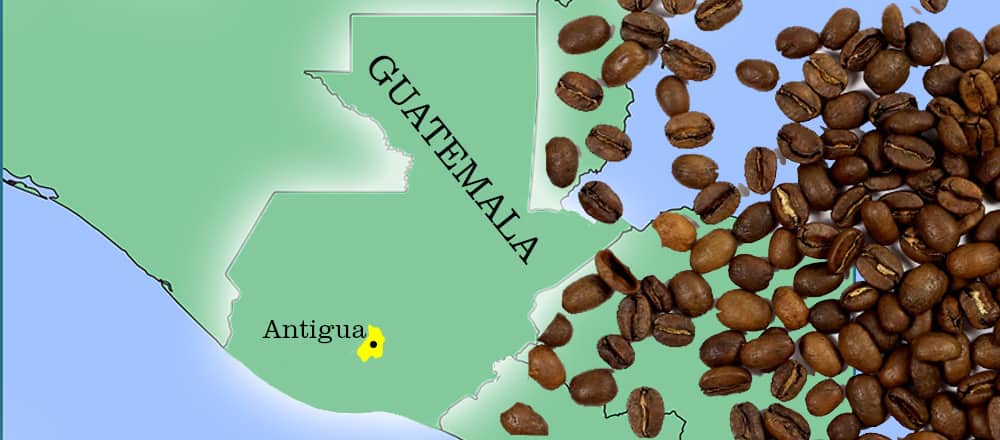
Antigua
Fertile volcanic soil, low humidity, ample sun and cool nights contribute significantly to the extraordinary quality of Antiqua-grown Guatemala Coffee. Indeed, many consider this Coffee region the best when it comes to quality and taste.
Three volcanoes named Agua, Fuego and Acatenango surround the valley around the town of Antigua (from which the region gets its name). Fuego, in particular, is one of Guatemala’s still active volcanoes, and often adds a fresh dusting of mineral rich-ash to the local soil.
Coffee is grown in Antigua with the added bonus of dense shade to protect it from the region’s occasional frost. Indeed, such are these ideal growing conditions that many Antigua Coffees fetch exceptionally high prices.
Harvest Season: January – March.
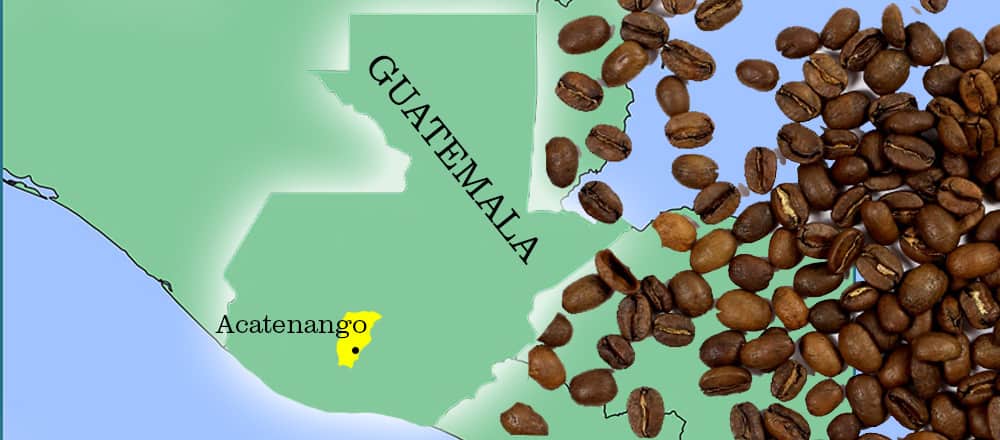
Acatenango
To the west of Antigua lies the Acatenango Valley, where Coffee grows under dense shade on steep slopes of up to 2,000 metres. Here, the influence of nearby Fuego has an equally positive impact on the soil as it does for Antigua Coffee. These eruptions keep the coarse, sandy soil full of minerals.
Warm winds blowing in from the Pacific Ocean enable Acatenago-grown Coffee to be sun-dried, which ultimately contributes to its profile. This growing region has only recently received the recognition it deserves. However, Coffees have grown here for some 100 years.
Harvest Season: December – March.
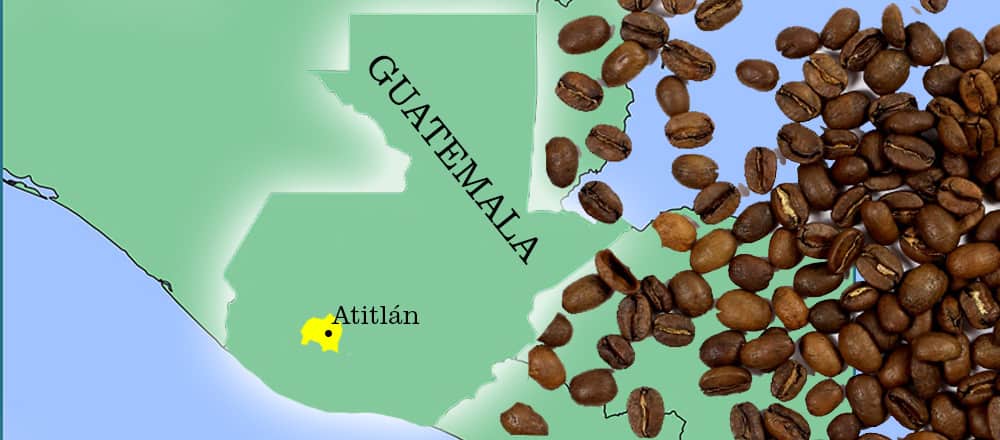
Atitlán
Atitlán is another Coffee growing region that utilises volcanic conditions. The vast majority of the Coffee grown here thrives along the slopes of the dramatic volcanoes that dominate the shores of Lake Atitlán. On these slopes, most is harvested from the Pacific side.
Producers in this region most commonly use the water from the lake for the wet processing of Guatemala Coffee beans. To find out more information on wet processing, please visit “The Coffee Process” section on our website.
Harvest Season: December – March.

Cobán
Seldom do Coffee growing regions get rainier than Cobán. In fact, the name “Cobán” comes from the Maya Keckchi word meaning “place of clouds”. As well as the overcast and wet conditions, the area is frequently engulfed by “chipi-chipi”, a mist so common that the Guatemalan people have named it! These elements combined create an incredible microclimate well-suited to Coffee.
While the high altitudes, limestone-clay soil and, for the most, climatic conditions contribute significantly to the quality of Cobán-grown Coffee, the rainforest environment can also be somewhat of a challenge. Indeed, complications arise when it comes to drying the Guatemala Coffee beans in such a microclimate. Ultimately, however, it’s worth the struggle.
Harvest Season: December – March.

Fraijanes
This region, specifically the Fraijanes Plateau, boasts fertile volcanic soil and plenty of rainfall, as well as suitable humidity for Coffee-growing. It’s here in Fraijanes that another active volcano (the most active of them all) can be found depositing ash frequently. This further boosts the near-perfect conditions for Fraijanes-grown Coffee.
It’s important to note, however, that these conditions can be divided into four distinct microclimate regions. This ensures that, depending on the region, each Coffee has its own unique profile variation. Indeed, rarely do two Coffees from Fraijanes taste the same.
Perhaps most noteworthy is the Guatemala Coffee Harvest Celebration that happens in Fraijanes. This takes place in February, just outside of Guatemala City. Its purpose is to celebrate the end of the harvest and all of its (hopefully) fruitful successes.
Harvest Season: December – February.
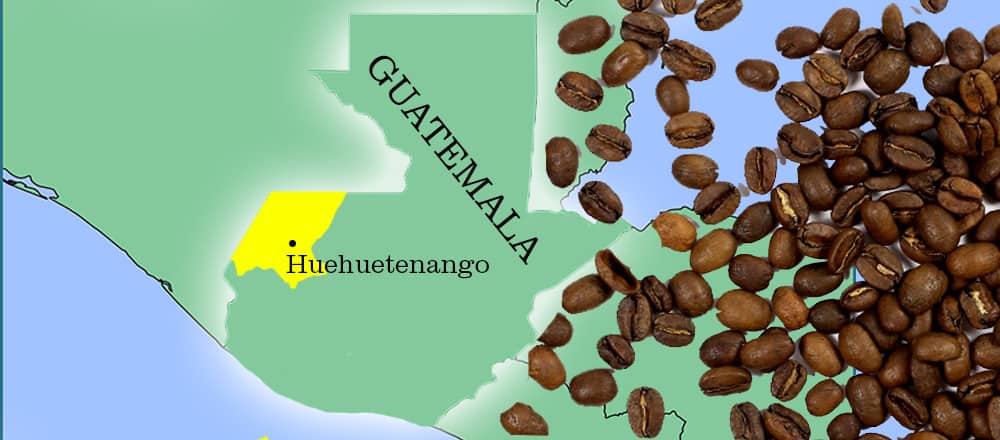
Huehuetenango
Huehuetenango has the highest altitudes of any Guatemalan Coffee-growing region. It is also one of the driest. This dryness is in part thanks to the hot winds blowing into the mountains from Mexico’s Tehuantepec plain, thus protecting its Coffee plants from frost. Situated at 6,500 feet (2,000 metres) above sea level, Huehuetenango has become synonymous with speciality Coffee beans.
A downside to growing Coffee in this region is its sheer remoteness. Indeed, it often means that growers must also process their Coffee, as opposed to transporting it elsewhere for processing. Fortunately, an abundance of rivers and streams make it relatively easy for producers to set up mills. Similar to the challenges of Cobán, Huehuetenango-grown Coffee is worth the struggle.
Harvest Season: January – April.
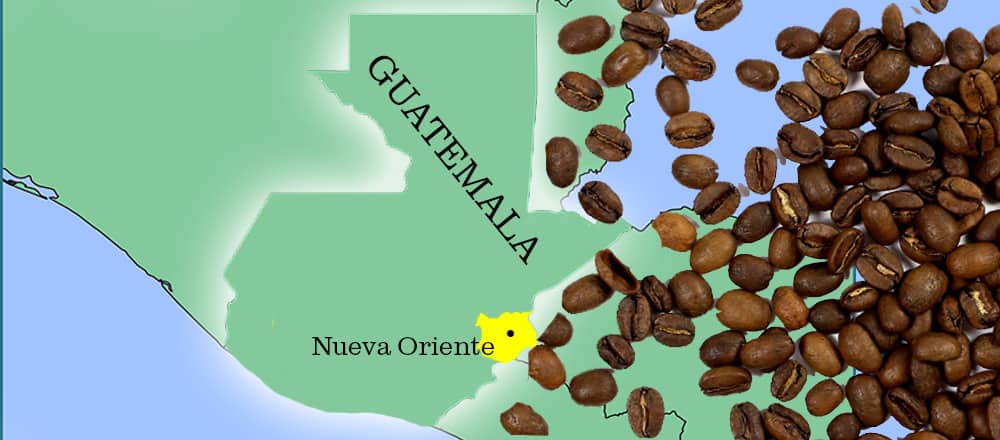
Nueva Oriente
Producers have grown Coffee in the Guatemalan region of Nueva Oriente since the 1950s. Over the course of many decades, the continual growth of the region’s Coffee industry has supported some of the poorest and most isolated communities of Guatemala. Inevitably, choosing a Coffee grown in Nueva Oriente is not only an excellent choice for the palate but also, and perhaps most importantly, an outstanding ethical choice.
The geography of this region is quite varied, its heights ranging from 245 to 1,360 metres above sea level. The climate, meanwhile, often fluctuates from bitterly cold to hot. Arguably the most crucial factor is the soil made up of mineral-rich metamorphic rock.
Harvest Season: December – March.
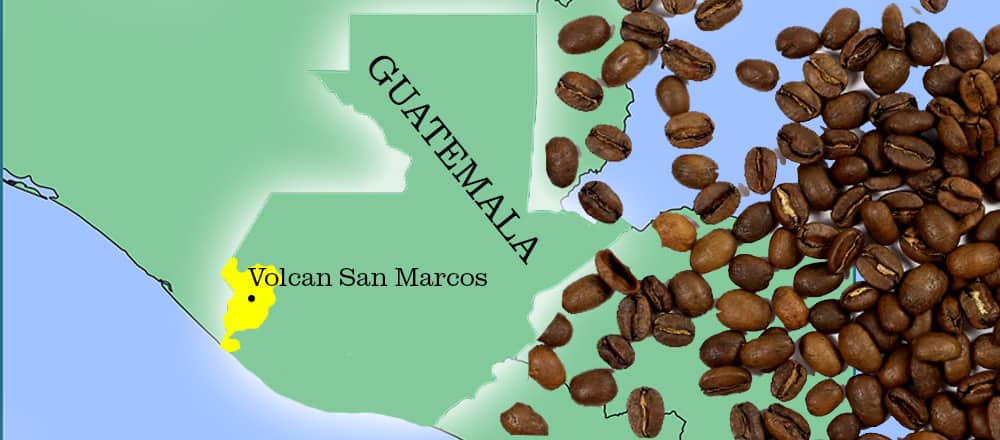
Volcan San Marcos
Volcan San Marcos is one of the wettest and warmest Coffee growing regions in Guatemala. It is also the first region to produce flowering Coffee plants each year. These plants grow at elevations between 1,200 metres and 1,800 metres (4,000 feet and 6,000 feet) above sea level. It also has an average rainfall of about 4,500 mm annually, with an average humidity of about 75%.
The biggest influencer on Volcan San Marcos’ climate is the nearby Pacific Ocean. This can, at times, lead to unpredictability, with much of the Coffee pre-dried in the sun when the moment arises, and finished in mechanical driers when the rain returns. Similar to Huehuetenango, the remoteness of this region means that most Coffee farms must have their own processing mills.
Harvest Season: December – March.
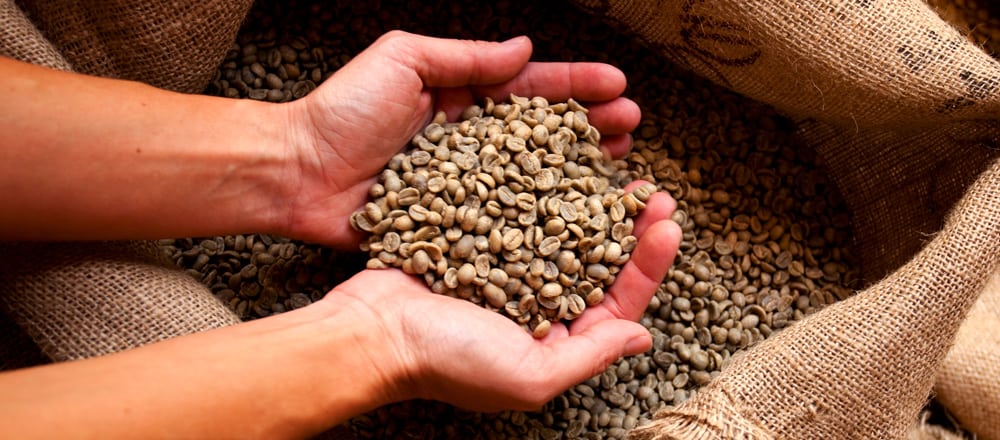
Guatemala Coffee Production
Regardless of the region, most Coffee plant varietals grown in Guatemala are Typica and Bourbon, both of which produce Arabica Coffee Beans. However, it isn’t wholly uncommon to occasionally see other varietals such as Catuai, Caturra and Pache.
The beans to come from these different plants have tastes that also differ significantly from one to another. In other words, each one has something unique to offer. Ultimately, Coffee-growing land in Guatemala covers 270,000 hectares, 98% of which is shade-grown.
At the factories, the most common Coffee process is the washed method. This sees the Coffee cherry pulped in a specially-designed machine, which separates the pulp and the seed’s outer layer from the bean. Guatemalan Coffee producers then divide the beans by weight while passing them through water channels.
The next stage sees the beans placed inside water-filled fermentation tanks. Here they remain from anywhere between 12 to 48 hours to remove the mucilage – another layer of the seed. At this point, producers rinse the beans once again before drying them. Finally, the beans are ready to either be exported or, if staying in Guatemala, roasted so that they’re ready for brewing!

Guatemala Coffee Profile and Taste
As mentioned previously, no two Guatemalan Coffees are the same. However, many connoisseurs describe them broadly as having a full body with strong, sweet notes and mild acidity. This, of course, can change depending on the type. It’s also worth noting that most have a relatively high Caffeine content.
Here at The Kent and Sussex Tea and Coffee Company, with over 70 types of coffee, all of which you can buy online.
Guatemalan Coffee: This is a high-grown, medium-roasted Coffee with a full body and excellent flavour. It is of a single origin, meaning all of the beans come from the same place as opposed to being blended with others.
Guatemalan Rainforest Alliance Coffee: This beverage belongs to our unique range of Ethical Coffees. It has the honor of being certified by the Rainforest Alliance, an international non-profit organisation focused on the sustainability of Coffee growing land. When brewed, it is a notably well-balanced infusion with sweet, acidic notes.
Guatemalan Maragogype Elephant Coffee: This, our Guatemala Elephant Coffee, is one of our most popular products. Period. Such is its popularity, in fact, that we’re often running out of stock! The name “elephant” refers to the large size of the beans. Best of all, it has smooth, mellow flavour notes with a full body and slight acidity.
But why should you choose us when buying your coffee online? We use the latest state-of-the-art Neuhaus Neotec fluidised air-bed system, which primarily uses convection heat transfer to roast the Coffee. This ensures not only quality but also consistency.

 Loose Leaf Tea
Loose Leaf Tea Pyramids
Pyramids Tea Bags
Tea Bags Africa
Africa Assam
Assam Ceylon
Ceylon Chinese
Chinese Darjeeling
Darjeeling European
European Indian
Indian Japan
Japan Nepal
Nepal South East Asia
South East Asia Ayurveda Tea
Ayurveda Tea Black Tea
Black Tea Chai Tea
Chai Tea Flowering Tea
Flowering Tea Fruit Tisanes
Fruit Tisanes Green Tea
Green Tea Herbal Tea
Herbal Tea Matcha Tea
Matcha Tea Oolong Tea
Oolong Tea Organic Tea
Organic Tea Pu erh Tea
Pu erh Tea Rooibos Tea
Rooibos Tea White Tea
White Tea Asian Coffee
Asian Coffee Caribbean Coffee
Caribbean Coffee Central American Coffee
Central American Coffee South American Coffee
South American Coffee Coffee Blends
Coffee Blends Decaffeinated Coffee
Decaffeinated Coffee Espresso Coffee
Espresso Coffee Ethically Sourced Coffee
Ethically Sourced Coffee Flavoured Coffee
Flavoured Coffee Organic Coffee
Organic Coffee Single Origin Coffee
Single Origin Coffee Chocolate 1
Chocolate 1 Chocolate 2
Chocolate 2 Chocolate 3
Chocolate 3 Chocolate 4
Chocolate 4 Chocolate 5
Chocolate 5 Chocolate 6
Chocolate 6 Chocolate 7
Chocolate 7 Chocolate 8
Chocolate 8 Chocolate 9
Chocolate 9 Loose Tea Filters
Loose Tea Filters Tea Accessories
Tea Accessories Tea Bricks
Tea Bricks Tea Caddies
Tea Caddies Tea Caddy Spoons
Tea Caddy Spoons Tea Gift Ideas
Tea Gift Ideas Tea Infusers
Tea Infusers Tea Strainers
Tea Strainers